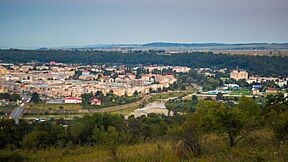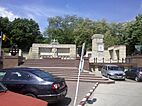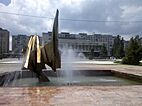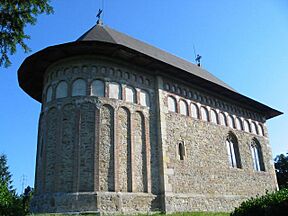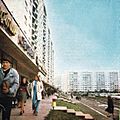Onești facts for kids
Quick facts for kids
Onești
|
|||
|---|---|---|---|
|
View from Perchiu Hill
Heroes Monument
Salt Crystal artesian well
Borzești Church
|
|||
|
|||
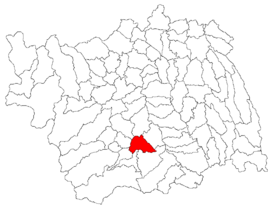
Location in Bacău County
|
|||
| Country | |||
| County | Bacău | ||
| Area | 52.48 km2 (20.26 sq mi) | ||
| Elevation | 210 m (690 ft) | ||
| Highest elevation | 398 m (1,306 ft) | ||
| Lowest elevation | 180 m (590 ft) | ||
| Population
(2011)
|
Lua error in Module:Wd at line 1,575: attempt to index field 'wikibase' (a nil value). | ||
| Time zone | EET/EEST (UTC+2/+3) | ||
| Postal code |
601003–601159
|
||
| Area code | (+40) 02 34 | ||
Onești is a city in Bacău County, Romania. It used to be called Gheorghe Gheorghiu-Dej. As of 2021, about 34,000 people live there. The city is located in the historical region of Moldavia.
Two villages, Slobozia and Borzești, are part of Onești.
Contents
History of Onești
Onești was first mentioned as a village in official documents on December 14, 1458. This means its history goes back a very long time!
How Onești Grew into a City
In 1952, leaders decided to build a large industrial area in the Onești and Borzești villages. This area would focus on making chemicals from oil. A new city was built around these factories.
Borzești is a very old place. Legend says it was the birthplace of Stephen III of Moldavia, a famous ruler. He ordered the building of the Borzești Church there in 1493–1494.
Onești's Name Change and Return
In March 1965, after a leader named Gheorghe Gheorghiu-Dej passed away, Onești was renamed in his honor. But in 1990, after the Romanian Revolution, the city's original name, Onești, was brought back.
Ancient Discoveries in Onești
Archaeologists found old pieces of settlements in the Malu area of Onești. These findings show that people lived here as far back as the Stone Age.
Geography of Onești
Onești is located in a valley called the Tazlău-Cașin Depression. This area is part of the Eastern Carpathian Mountains. The city is about 210 meters (689 feet) above sea level.
Rivers and Location
Onești is where several rivers meet: the Trotuș, Cașin, Oituz, and Tazlău. It is about 60 kilometers (37 miles) southwest of Bacău, the county capital.
Roads and Transport in Onești
Important roads pass through Onești. The European road E574 connects it to other parts of Europe. National roads DN11A and DN12A link Onești to Bucharest and other Romanian cities. The city also has train connections. A new highway, the A13, is planned to further connect Onești to Romania's major cities.
Population of Onești
| Historical population | ||
|---|---|---|
| Year | Pop. | ±% |
| 1930 | 3,828 | — |
| 1956 | 11,253 | +194.0% |
| 1966 | 35,663 | +216.9% |
| 1977 | 41,738 | +17.0% |
| 1992 | 58,810 | +40.9% |
| 2002 | 51,681 | −12.1% |
| 2011 | 39,172 | −24.2% |
| 2021 | 34,005 | −13.2% |
| Source: Census data | ||
In 2011, Onești had about 39,172 people. Most of them (over 90%) were Romanians. There were also smaller groups of Roma, Hungarians, and Greeks. By 2021, the population was 34,005. Most people were still Romanians, and for some, their ethnic background was not recorded.
Economy of Onești
Borzești is a neighborhood in Onești. It was once a separate village. The Borzești Petrochemical Plant is located there. This plant is a big part of the city's economy. It makes chemicals from oil.
Culture in Onești
Saint Nicholas is the special protector, or "patron saint," of Onești. Most people in the city belong to the Romanian Orthodox Church. Saint Nicholas Day, on December 6, is celebrated as the city's special day.
Places to Visit in Onești
If you visit Onești, you might enjoy:
- Perchiu Hill and the Hero Cross on top of it.
- The Municipal History Museum, where you can learn about the city's past.
- A steel monument dedicated to the famous Romanian poet Mihai Eminescu.
- The city park, a nice place to relax.
Mayors of Onești
The mayor is the leader of the city government. Here are some of the people who have served as mayor of Onești:
- Emil Lemnaru (PSD), from 1996 to 2012
- Victor-Laurențiu Neghină (PSD), from 2012 to 2015
- Alexandru Cristea (UNPR), from 2015 to 2016
- Nicolae Gnatiuc (PSD), from 2016 to 2020
- Victor-Laurențiu Neghină (PMP), from 2020 to 2024
Famous People from Onești
Many talented people were born in Onești, including:
- Diana Chelaru (born 1993), a gymnast
- Nadia Comăneci (born 1961), a world-famous gymnast
- Daniel Dines (born 1972), an entrepreneur
- Teodora Enache (born 1967), a jazz singer
- Georgeta Gabor (born 1962), a gymnast
- Loredana Groza (born 1970), a singer
- Ana Maria Pavăl (born 1983), a wrestler
Twin Towns and Sister Cities
Onești has special friendships with other cities around the world. These are called "twin towns" or "sister cities":
Images for kids
See also
 In Spanish: Onești para niños
In Spanish: Onești para niños


